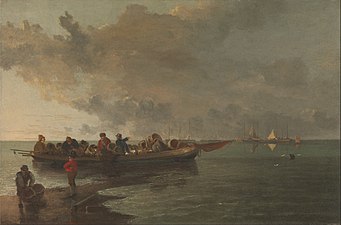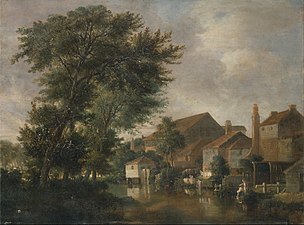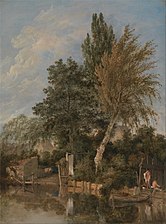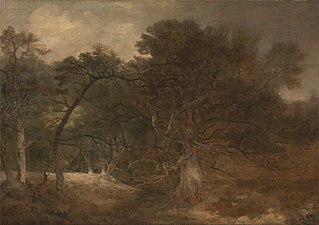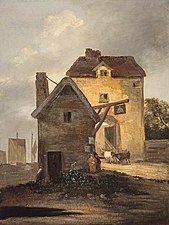John Crome
John Crome | |
|---|---|
 Portrait by Michael William Sharp | |
| Born | John Crome 22 December 1768 Norwich, England |
| Died | 22 April 1821 (aged 52) Norwich |
| Nationality | English |
| Movement | Norwich School of painters |
| Spouse | Phoebe Berney |
| Children |
|
John Crome (22 December 1768 – 22 April 1821), once known as Old Crome to distinguish him from his artist son John Berney Crome, was an English landscape painter of the Romantic era, one of the principal artists and founding members of the Norwich School of painters. He lived in the English city of Norwich for all his life. Most of his works are of Norfolk landscapes.
Crome's work is in the collections of public art galleries, including the
and taught art.Biography
John Crome was born on 22 December 1768 in
Crome and Ladbrooke sold some of their work to a local printseller, Smith and Jaggars,[8] and it was probably through the print-seller that Crome met Thomas Harvey of Old Catton, who helped him set to up as a drawing teacher.[2] Crome had access to Harvey's art collection, which allowed him to develop his skills by copying the works of Thomas Gainsborough and Meindert Hobbema. Crome received further instruction and encouragement from the artist John Opie, and the English portraitist William Beechey, whose house in London he frequently visited.[9]
In October 1792 Crome married Phoebe Berney.[10] They produced two daughters and six sons, two of whom, John Berney Crome and William Henry Crome became landscape painters.[11]
In 1803 Crome and Ladbrooke formed the Norwich Society of Artists, a group that also included
Crome was drawing master at Norwich School for many years. Several members of the Norwich School art movement were educated at the school and were taught by him,[14] including Stark and Edward Thomas Daniell.[15] He also taught privately, his pupils including members of the influential Gurney family, whom he stayed with whilst in the Lake District in 1802.[8]
He died at his house in Gildengate, Norwich, on 22 April 1821, and was buried in St. George's Church. On his death-bed he is said to have gasped, "Oh Hobbema, my dear Hobbema, how I have loved you".[2] A memorial exhibition of more than 100 of his works was held in November that year by the Norwich Society of Artists.[8]
An incident in Crome's life was the subject of the one-act opera Twice in a Blue Moon by Phyllis Tate, to a libretto by Christopher Hassall: it was first performed in 1969. In the story Crome and his wife split one of his paintings in two to sell each half at the Norwich Fair.[16]
Works

Crome, who is sometimes referred to as "Old Crome",
Between 1809 and 1813 he made a series of etchings. They were not published in his lifetime, although he issued a prospectus announcing his intention to do so.[18]
His two main influences are considered to be
The art historian
Gallery
-
The Poringland Oak (c.1818), National Gallery
-
A Barge with a Wounded Soldier (undated), Yale Center for British Art
-
The River Wensum, Norwich (c.1814), Yale Center for British Art
-
Yarmouth Jetty (c.1810), Yale Center for British Art
-
Boys Bathing on the River Wensum, Norwich (1817), Yale Center for British Art
-
Woodland Landscape near Norwich (1810–1812), Yale Center for British Art
-
The Bell Inn (c.1805),National Galleries of Scotland
Notes
References
- ^ Clifford & Clifford1968, p. 28.
- ^ a b c d Stephen 1888, pp. 140–143.
- ^ Mottram 1931, p. 25.
- ^ Binyon 1897, pp. 7–8.
- ^ Mottram 1931, p. 30.
- ^ Goldberg 1978, p. 38.
- ^ Cundall 1920, p. 8.
- ^ a b c Cundall 1920, p. 9.
- ^ a b c Chisholm 1911, pp. 483–484.
- ^ Cundall 1920, p. 10.
- ^ "William Henry Crome | 74 Artworks at Auction | MutualArt". www.mutualart.com. Retrieved 12 August 2023.
- ^ Walpole 1997, p. 19.
- ^ a b Cundall 1920, p. 11.
- ^ Cundall 1920, pp. 1, 17, 25, 26, 27, 31
- ^ Cundall 1920, p. 32.
- ^ Farnham Festival (1969). "Twice in a Blue Moon" (PDF). Phyllis Tate. Archived (PDF) from the original on 3 July 2018. Retrieved 17 June 2021.
- ^ Cole & Van Dyke 1902, p. 141.
- ^ Cundall 1920, p. 15.
- ^ Hemingway 2016, p. 302.
- ^ "Boys Bathing on the River Wensum, Norwich". Yale Center for British Art. Retrieved 20 August 2018.
- ^ Hemingway 2016, p. 347.
Sources
- OCLC 251906700.
- Chisholm, Hugh, ed. (1911). . Encyclopædia Britannica. Vol. 7 (11th ed.). Cambridge University Press.
- Clifford, Derek; Clifford, Timothy (1968). John Crome. London: Faber and Faber Ltd. OCLC 557807587.
- Cole, Timothy; Van Dyke, John Charles (1902). Old English Masters. New York: The Century Co. OCLC 975407215.
- Cundall, Herbert Minton (1920). Holme, Geoffrey (ed.). The Norwich School. London: Geoffrey Holme Ltd. OCLC 651802612.
- Goldberg, Norman L. (1978). John Crome the Elder. Vol. 1: Text and a critical catalogue. Phaidon Press. ISBN 978-0-7148-1821-4.
- Hemingway, Andrew (2016). Landscape between Ideology and the Aesthetic: Marxist Essays on British Art and Art Theory, 1750–1850. Brill. p. 302. ISBN 978-90-04-26901-9.
- OCLC 717763630.
- Stephen, Leslie, ed. (1888). . Dictionary of National Biography. Vol. 13. London: Smith, Elder & Co. pp. 140–143.
- Walpole, Josephine (1997). Art and Artists of the Norwich School. Woodbridge, UK: Antique Collectors' Club. ISBN 978-1-85149-261-9.
Further reading
- Moore, Andrew W. (1985). The Norwich School of Artists. Norwich: HMSO/Norwich Museums Service. ISBN 978-0-11-701587-6.
- Theobald, Henry Studdy (1906). Crome's Etchings; a catalogue and an appreciation, with some account of his paintings. London: MacMillan and Co. Ltd. OCLC 250577003.
External links
- John Crome in "England Births and Christenings, 1538–1975", FamilySearch. (registration required)
- Artworks by or after John Crome at the Art UK site
- Works by (or relating to) John Crome at the British Museum
- Works by (or relating to) John Crome in the Norfolk Museums Collections
- Works by (or relating to) John Crome at the Yale Center for British Art




